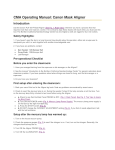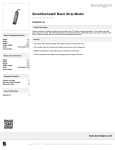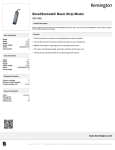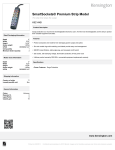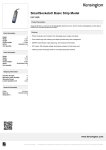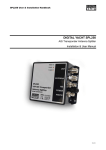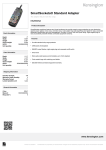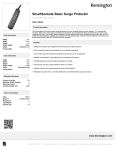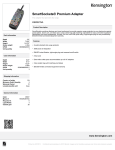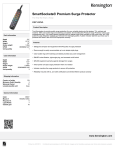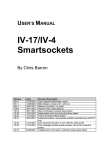Download MOZ04
Transcript
MOZ04
Proceedings of PCaPAC08, Ljubljana, Slovenia
CMSG – A PUBLISH/SUBSCRIBE INTERPROCESS COMMUNICATION
PACKAGE
E. Wolin, D. Abbott, V. Gyurjyan, G. Heyes, E. Jastrzembski, D. Lawrence, C. Timmer, Jefferson
Lab, Newport News, VA 23606, U.S.A.
Abstract
Publish/subscribe message passing is an extremely
simple,
flexible,
and
powerful
interprocess
communication (IPC) paradigm. It is widely used in
industry, but not nearly so in High Energy and Nuclear
Physics (HENP), perhaps due to the cost of commercial
implementations. cMsg, developed at Jefferson Lab in the
US, contains a full-featured pub/sub interprocess
communication package that is simple to install and use.
It is very efficient, and implements both point-to-point
and pub/sub communications, server redundancy, hot
server failover, and a server discovery service. In addition,
for developers cMsg provides a framework within which
one can deploy multiple underlying communication
packages that do not necessarily need to implement the
full pub/sub paradigm. This allows for unification of all
communication in a control system under a single API,
shortens development time, and allows for simple upgrade
or replacement of underlying communication packages
and protocols.
INTRODUCTION
Interprocess communication packages based on the
publish/subscribe paradigm are not widely used in particle
and nuclear physics experiments and accelerator systems.
The LHC uses SoniqMQ in its LASER alarm system,
CDF at Fermilab uses Tibco SmartSockets to control
front-end single-board computers in its DAQ system, and
at Jefferson Lab for over a decade the CLAS experiment
has also used SmartSockets in its online control system.
Based on its highly successful use in CLAS, the JLab
DAQ group decided to develop its own pub/sub IPC
package as the foundation for all interprocess
communication in the next generation of JLab DAQ
software. An additional requirement was that the package
provide a framework and proxy service under which
legacy JLab IPC packages could be deployed, a
requirement not satisfied by any commercial or public
domain package, including recent Java Message Service
(JMS) implementations. Licensing and distribution issues
further led us to develop our own package.
In the following we first describe the pub/sub paradigm
and make a clear distinction between it and others, such as
the client/server paradigm (note that there is much
confusion about this distinction in the HENP community).
Next we describe the pub/sub implementation in the cMsg
package from a client or user point of view. After this we
discuss the cMsg package from the developer point of
view, especially its framework and proxy server features.
Next we briefly discuss cMsg performance, then conclude
with a summary.
Classical Topics
28
WHAT IS PUBLISH/SUBSCRIBE
The publish/subscribe paradigm is deceptively simple,
but quite powerful and general [1]. Producers publish
messages asynchronously to abstract “subjects” or
“topics” with no knowledge of whom, if anyone, might
receive the messages, nor how or when the messages are
delivered. Subjects are arbitrary strings that can be
created at will, and multiple producers can publish to the
same subject. Partitioning of the messaging space is
accomplished via suitable naming conventions in the
subject space.
Consumers subscribe to subjects with no knowledge of
who may publish to them. A single process can be both a
producer and a consumer, and may subscribe to the same
subjects it publishes to. Messages are typically processed
asynchronously via callbacks.
Key features are that many producers can publish to the
same subject, producers can publish messages at will and
not just as a response to a request, and that producer and
consumer processes are completely decoupled.
In
contrast, many IPC systems require coordination between
processes that communicate with each other, and the
disappearance of one has effects on the other.
Comparing Pub/Sub to Client/Server
In client/server systems the client initiates contact with
a server facility requesting the server to perform some
action on its behalf. Usually, but not always, the server
sends a response back to the client, sometimes more than
one response over an extended period.
This model can easily be implemented in a pub/sub
system. “Client” processes need only publish request
messages to unique subjects that other “server” processes
subscribe to, and provide a unique subject that the client
subscribes to. The server processes send responses to the
unique client subjects.
Note that the reverse, implementing a pub/sub model
using a client/server system, is quite complicated.
Many other IPC paradigms can be implemented within
a pub/sub system. Some of these will be discussed in the
following sections.
WHAT IS CMSG – CLIENT
PERSPECTIVE
The cMsg package includes a full-featured pub/sub
facility that implements compound message payloads and
automatic endian swapping. Payloads can contain
arbitrary combinations of primitive types, arrays of
primitive types, cMsg messages, and arrays of cMsg
Control Software: Applications and Tools
Proceedings of PCaPAC08, Ljubljana, Slovenia
messages. API’s are provided for C, C++ and Java, and
cMsg is supported on many flavors of Unix and
VxWorks. Unlike other pub/sub implementations, cMsg
subscriptions and message routing are based on a pair of
fields, subject and type. Both can be arbitrary strings and
are treated identically. Wildcard characters are supported
in subscriptions.
Message routing is performed by one or more
cooperating cMsg server processes that can be deployed
as needed to equalize cpu and network loads. Server
features include hot failover, a server discovery service,
and a system monitoring facility. The cMsg server is
written completely in Java.
The client API is designed to be as simple as possible.
No interface definition files, stub generators, or similar
things are required.
cMsg includes many more features than just this
facility, and these will be discussed in the section aimed at
developers below. It is not necessary to understand the
concepts in the developer’s section to successfully use the
cMsg pub/sub facility, though.
The following C++ code fragments demonstrate how to
connect to the cMsg system and how to send and receive
messages. Note that a single process can have multiple
connections to the cMsg system, if needed.
Sending a Message
#include <cMsg.hxx>
// connect to cMsg system, UDL specifies messaging space
cMsg c(UDL, “myName”, ”My description”);
c.connect();
// create and fill message object
cMsgMessage msg;
msg.setSubject(“mySubject”);
msg.setType(“myType”);
msg.setText(“This is my text”);
// send message
c.send(msg);
Receiving a message
#include <cMsg.hxx>
// connect to cMsg system
cMsg c(UDL, “myName”, “My description”);
c.connect();
// subscribe and start receiving
c.subscribe(“mySubject”, “myType”, new myCallback(), NULL);
c.start();
// do something else…
where the callback class is:
class myCallback : public cMsgCallback {
// see user manual for description of userObject
void callback(cMsgMessage* msg, void* userObject) {
cout << "Message subject is: " << msg->getSubject() << endl;
}
};
Classical Topics
MOZ04
Universal Domain Locator (UDL)
The UDL, a runtime parameter, specifies how to find
and connect to a cMsg message server or broker, and
which logical messaging space should be used. UDL
server information includes a host name and port, or
“multicast” in which the first server to respond is chosen.
The logical messaging space name is just an arbitrary
string, and messages in one space will not be delivered to
another space. A simple example UDL using default
ports is:
cMsg://ollie.jlab.org/cMsg/myMessageSpace
See the cMsg manual for a complete discussion of UDL
syntax and semantics [2].
WHAT IS CMSG – DEVELOPER
PERSPECTIVE
Note that it is not necessary to understand the concepts
in this section to use the full cMsg pub/sub facility.
Some important cMsg design requirements were to
provide a framework under which legacy communication
protocols could be unified under a single API, and to
provide a mechanism to allow processes running on any
operating system to access legacy protocols, even if no
legacy library existed on that system. For example, some
of our legacy protocols are not supported on VxWorks.
This led to two key concepts: “domains” implemented
in a client-side framework, and “subdomains”
implemented in a proxy-server facility.
Framework
Connection to an underlying communication system in
the cMsg package is controlled by the UDL, a string that
specifies the kind of communication desired and how to
connect to the system implementing it. Which system or
“domain” to connect to is determined at runtime in the
client when it parses the UDL.
Many domains are provided, and new ones can easily
be added to the client framework. Included are the cMsg
domain (main focus of this article), FILE domain, EPICS
Channel Access [3] domain, and others described in the
user’s manual found on the FTP site [2]. Technically,
specifying the cMsg domain only results in connection to
the proxy server described in the next section.
Note that the messaging API is independent of which
domain is selected at runtime.
Domains do not
necessarily implement the full publish/subscribe
paradigm.
Proxy Server
If the cMsg domain is specified in the UDL the client
connects to a cMsg domain server process. The server
parses additional fields in the UDL to determine which
“subdomain” handler class should be used to implement
Control Software: Applications and Tools
29
MOZ04
Proceedings of PCaPAC08, Ljubljana, Slovenia
the communications. The subdomain code may well
employ a communication library unavailable on the client
node. A private protocol is used to transport message data
from the client to the cMsg server.
Many subdomains are available, and new ones can
easily be added (in Java only). The cMsg subdomain
implements the full pub/sub system that is the main focus
of this article. Other subdomains include the Queue
subdomain, FileQueue subdomain, LogFile subdomain,
EPICS Channel Access subdomain, and others described
in the user’s manual [2].
To be precise, the full pub/sub system described in this
article entails communicating via the cMsg domain
handler in the client-side framework to the proxy server,
and use of the cMsg subdomain handler in the proxy
server itself [4].
Note that although the underlying implementation
involves use of the client/server model, due to the nature
of the networking libraries, from the user point of view
the cMsg system implements a pure publish/subscribe
model.
CMSG PERFORMANCE
cMsg performance requirements were modest, and were
mainly aimed at controls applications. But modern cpu’s
and Java are so fast that cMsg performance exceeded our
requirements by orders of magnitude. This allowed us to
extend the range of cMsg applications to include all but
the highest speed data acquisition applications. For the
latter we use a high-speed shared-memory based data
transfer system [5].
Briefly, on modern systems and for message sizes
above 1 kByte, data transfer rates are limited by network
performance (i.e. over 800 Mbits/sec using GBit Ethernet)
with cpu loading less than 20%. For smaller messages, up
to 1 kByte, overhead in the network driver begins to
dominate, the network does not saturate, and messaging
rates top out at around 25,000 messages/sec.
Messaging and data rates are up to three times higher
for local messaging, i.e. where producer, server, and
consumer reside on the same node and the network is not
accessed.
Classical Topics
30
SUMMARY AND CONCLUSIONS
The publish/subscribe messaging paradigm is powerful
and flexible, and can satisfy almost all messaging
requirements in HENP control and DAQ applications.
The cMsg package includes a full-featured asynchronous
publish/subscribe messaging component that is simple to
use, robust, and has very high performance. It provides
C, C++, and Java API’s, and runs on many flavors of
Unix.
For developers, cMsg can additionally be used as a
framework to unify all communications in a control or
DAQ system, and provides a Java proxy server that can
allow processes running on a node to access
communication protocols not supported on that node.
It is unfortunate that the publish/subscribe paradigm is
not particularly well known or understood in the HENP
community, particularly compared to the client/server
paradigm, as our experience shows it to be an excellent
match to our requirements. In the past this may have been
partly due to the cost of commercial implementations.
The cMsg package is freely available to those working
in HENP and other research fields [2].
REFERENCES
[1] See the Wikipedia entry on pub/sub messaging:
http://en.wikipedia.org/wiki/Publish/subscribe.
[2] The cMsg manual and package can be downloaded
from ftp://ftp.jlab.org/pub/coda/cMsg.
[3] See http://www.aps.anl.gov/epics.
[4] Thus the cMsg domain handler class and the cMsg
subdomain handler class are distinct, and perform
completely different tasks. Only the names are the
same, perhaps a source of mild confusion. This is
why “cMsg” is repeated twice in the example UDL,
once to specify the cMsg domain, and again to
specify the cMsg subdomain.
[5] C. Timmer, D.J. Abbott, W.G. Heyes, E.
Jastrzembski, R.W. MacLeod and E. Wolin, “Fast
Transfer of Shared Data”, CHEP 2000, Padova, Italy,
p. 585-588 (2000).
Control Software: Applications and Tools




